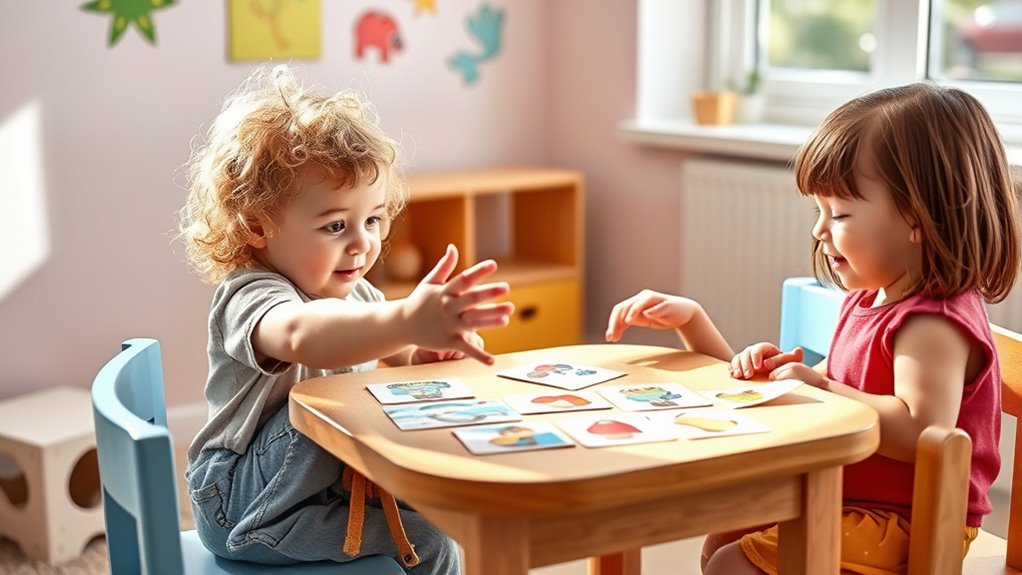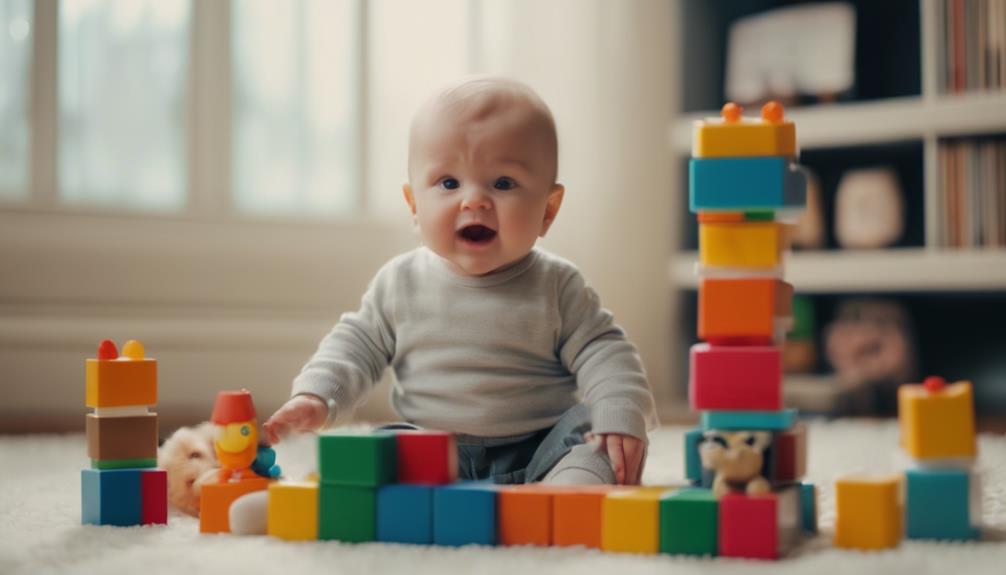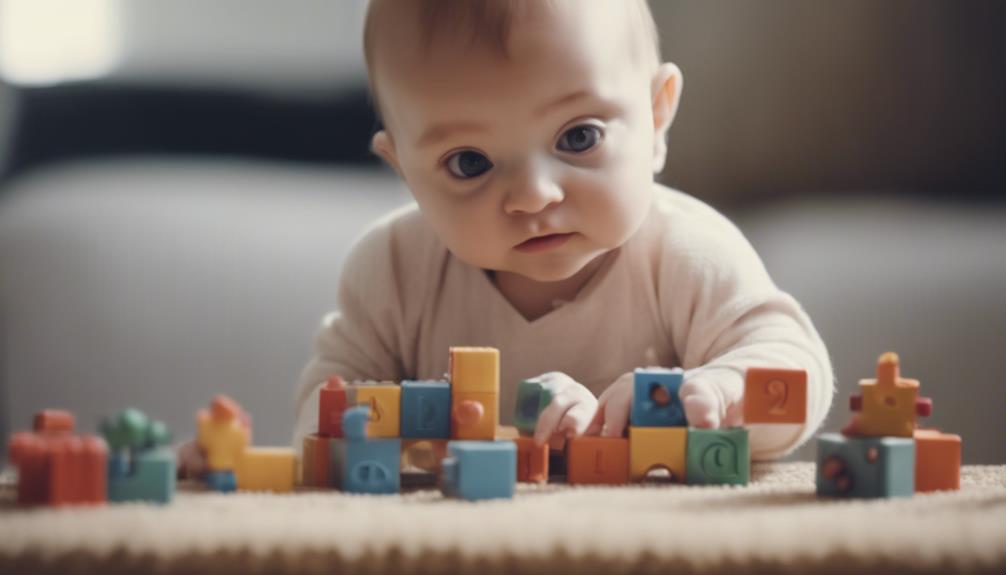To boost your baby or toddler’s memory, try simple matching puzzles, hide and seek games, or sensory play activities. You can also use memory card games, storytelling, and repetition to strengthen recall. Incorporate sequencing and sorting activities to develop logical thinking. Musical games and categorization exercises further enhance memory skills. By exploring these fun and engaging activities, you’ll discover many ways to support your child’s cognitive growth—more ideas are just ahead.
Key Takeaways
- Use simple matching games with colorful images to enhance visual memory and recognition skills.
- Incorporate hide-and-seek activities to develop object permanence and recall abilities.
- Engage in sequencing and pattern recognition tasks, like puzzles, to boost logical thinking and memory.
- Play memory card games with familiar images and sounds to strengthen visual and auditory memory links.
- Incorporate storytelling and repetition activities to reinforce memory retrieval and cognitive development.
Simple Matching Puzzles to Enhance Recognition Skills

Simple matching puzzles are an excellent way to boost your baby or toddler’s recognition skills. These puzzles help develop key cognitive abilities like color recognition and shape matching. As your child sorts pieces by color, they learn to distinguish shades and hues, building their visual vocabulary. Shape matching encourages them to identify different forms and understand how objects relate to each other. By engaging with these puzzles, your little one practices focusing their attention and improves hand-eye coordination. Keep the puzzles simple and colorful, making them inviting for your child’s curiosity. As they succeed in matching colors and shapes, their confidence grows, laying a strong foundation for more complex cognitive skills later on. Incorporating early learning activities with matching puzzles can further enhance their development. These activities make learning fun and interactive for your toddler, promoting developmentally appropriate skills through playful exploration. Additionally, choosing puzzles that are age-appropriate ensures your child remains engaged and challenged without feeling overwhelmed. Recognizing the importance of visual development can help you select the most beneficial puzzles to support their overall growth. Introducing these activities early can also support the development of problem-solving abilities, which are crucial for their overall growth.
Hide and Seek Games for Memory and Recall

Playing hide and seek helps your little one develop spatial awareness as they learn to find and hide in different spots. It also strengthens their understanding of object permanence, knowing that things still exist even when out of sight. Plus, this game encourages problem-solving as they figure out where to hide or look for others. Incorporating age-appropriate toys can make the game even more engaging and safe for your child. Additionally, using essential oils like lavender or eucalyptus in a diffuser nearby can create a calming environment during playtime. Engaging in such activities can also support the development of cognitive skills, which are essential for memory growth. Furthermore, integrating educational games aligned with developmental milestones can enhance overall learning and retention. Understanding sensorial development can also help tailor activities to boost your child’s memory and perception skills.
Enhancing Spatial Awareness
To boost your baby’s spatial awareness, incorporating hide and seek games into their playtime is highly effective. These games help your little one develop essential skills like spatial orientation and positional awareness. As they search for hidden objects or friends, they learn to understand how objects are positioned relative to their surroundings. You can hide toys behind furniture or under cloths, encouraging your baby to explore different spaces. This active engagement promotes their ability to judge distances and understand where things are in relation to themselves. Recognizing the importance of work-life balance can also help ensure your child’s development remains a priority, as a well-rounded environment fosters healthy growth. Additionally, engaging in play-based learning activities like hide and seek can stimulate brain development and enhance cognitive skills. Creating a safe and stimulating environment with child-friendly spaces can further support their exploration and learning. Incorporating developmentally appropriate activities can optimize their growth and understanding. Keep the game fun and simple, and watch their awareness grow naturally.
Developing Object Permanence
Building on spatial awareness, hide and seek games are also excellent for developing your baby’s understanding of object permanence. This skill, a key developmental milestone, helps your little one realize that objects still exist even when out of sight. Playing simple hide and seek with toys or yourself encourages them to search and anticipate, strengthening their recall and memory. Use the table below to guide your activities:
| Activity | Developmental Benefit |
|---|---|
| Hide a toy under a cloth | Recognizing hidden objects |
| Peekaboo | Understanding object permanence |
| Cover and uncover objects | Improving recall and memory |
| Seek and find games | Enhancing problem-solving and recall |
These games support your child’s growth by fostering their understanding that objects persist beyond immediate view, marking important developmental milestones. Additionally, incorporating social interaction during these activities can further enhance their cognitive development. Moreover, integrating predictive analytics concepts can help parents tailor activities to suit their child’s developmental pace, ensuring more effective learning experiences.
Encouraging Problem Solving
Hide and seek games are excellent tools for encouraging problem solving and strengthening your child’s memory and recall skills. As your little one searches for you or hidden objects, they practice problem solving strategies like analyzing clues and making predictions. These games also serve as critical thinking exercises, helping them develop reasoning skills and learn to overcome obstacles. You can enhance this process by hiding objects in different spots and encouraging your child to find them, prompting them to think critically about where items might be. Incorporating various hiding spots into play can also boost their cognitive development by promoting a healthy skin environment that supports overall growth. Additionally, the act of searching and discovering can improve their attention span and focus. Incorporating exfoliation techniques into play can also boost their cognitive development by promoting a healthy skin environment that supports overall growth. Engaging in diverse problem solving activities during playtime further stimulates neural connections and enhances mental agility. This combination of fun and learning promotes cognitive growth, setting a strong foundation for future learning challenges. Furthermore, trying different types of memory games can help solidify their recall abilities and make learning even more engaging.
Sensory Play Activities to Stimulate Brain Development
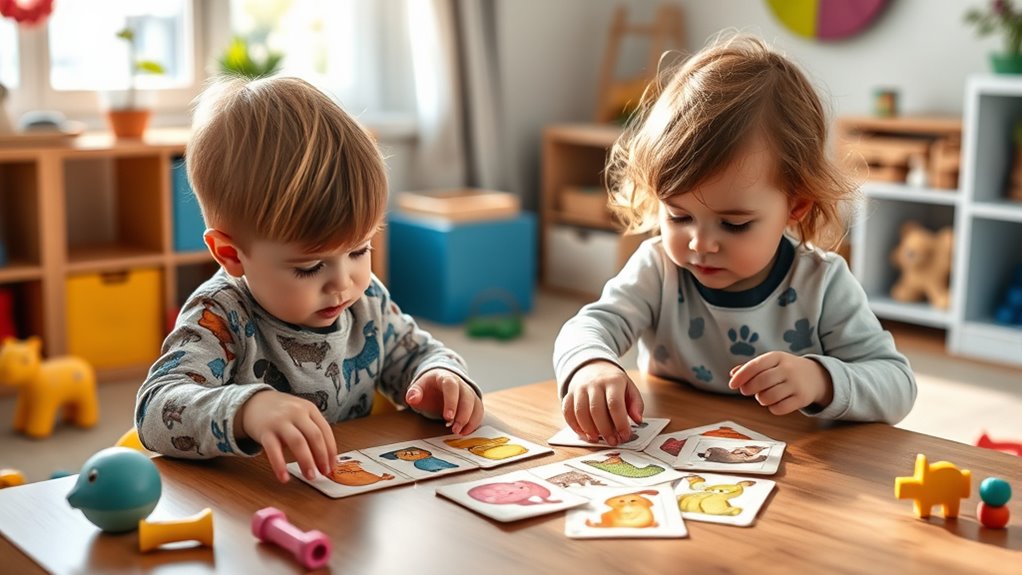
Sensory play activities are great for boosting your little one’s brain development. You can create textured sensory bins, incorporate sounds and touch, or introduce visual stimulation activities to keep them engaged. These hands-on experiences help develop their senses and strengthen their memory skills. Including elements like eye patches in imaginative play can also promote focus and visual awareness as part of their sensory exploration. Additionally, engaging in early childhood development activities like these supports cognitive growth and sensory integration.
Textured Sensory Bins
Textured sensory bins are a wonderful way to engage babies and toddlers in tactile exploration that promotes brain development. These bins offer a variety of materials that stimulate their senses and encourage fine motor skills. By exploring different textures, your child sharpens their sensory processing and enhances memory through hands-on interaction. Creating textured sensory bins is simple—you can include items like soft fabric, rough sandpaper, bumpy balls, smooth stones, or squishy sponges. Incorporate themes or objects to make each experience unique. Regular play with textured sensory bins fosters curiosity, improves tactile discrimination, and supports overall brain growth. Keep the activities safe, supervised, and fun to maximize your child’s sensory and memory development.
Sound and Touch Play
Engaging your baby or toddler in sound and touch play is an effective way to boost their brain development through active exploration. Tactile exploration helps them understand different textures, while sound identification sharpens their auditory senses. Use soft fabrics, textured toys, or household objects with varied surfaces to encourage tactile exploration. Simultaneously, introduce toys that produce different sounds, such as rattles or musical instruments, to develop their ability to recognize and differentiate noises. Encourage your child to touch, hold, and shake objects, describing the sensations and sounds they experience. This hands-on approach stimulates multiple senses, promotes neural connections, and enhances memory. Regular sound and touch play creates a foundation for more complex cognitive skills and keeps your little one engaged in meaningful learning.
Visual Stimulation Activities
Building on the foundation of sound and touch play, incorporating visual stimulation activities can considerably enhance your baby’s brain development. Engaging their eyes with colorful and contrasting visuals encourages focus and helps develop color recognition. You can introduce simple activities like showing high-contrast black-and-white images or colorful toys to boost visual tracking. Shape differentiation becomes easier when you present objects with distinct forms, such as circles, squares, and triangles. These activities not only stimulate the visual cortex but also support overall cognitive growth. To make it engaging, try using bright mobiles, picture books, or textured flashcards. Consistent exposure to visual stimuli strengthens neural connections, laying a solid foundation for memory and learning. Incorporate these activities daily to foster your little one’s visual and cognitive skills effectively.
Memory Card Games Designed for Little Learners
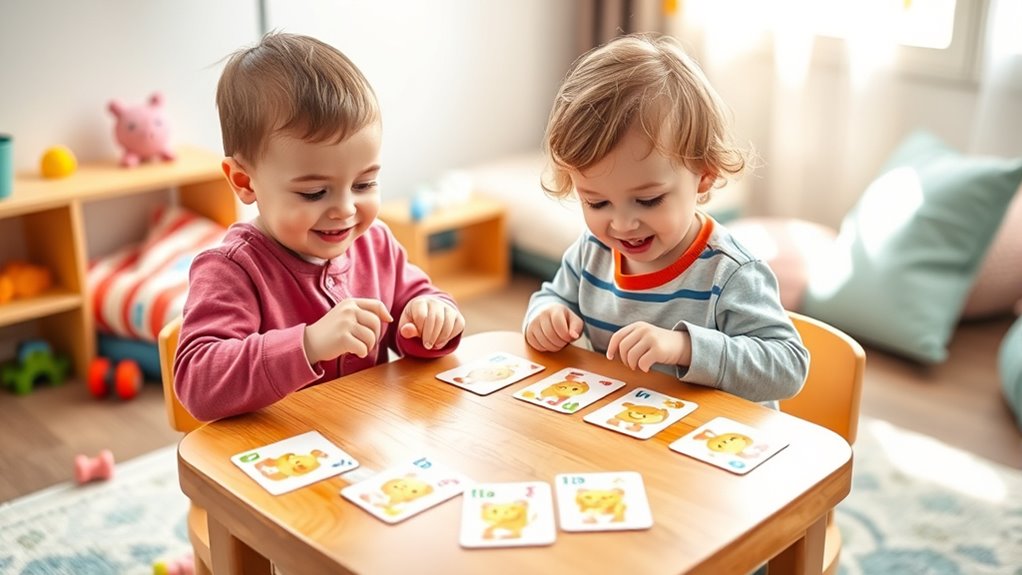
Memory card games are an excellent way to help little learners develop their cognitive skills while having fun. These games are designed to strengthen visual memory by encouraging children to recall the images they’ve seen. You can choose cards with simple, colorful pictures that capture their attention. As they match pairs, they improve their ability to remember visual details. Additionally, incorporating auditory recognition can enhance their memory skills; for example, playing sounds or names associated with each card helps children connect visual cues with sounds. Repeating this process boosts both their visual and auditory memory, laying a solid foundation for future learning. Keep the games engaging, and watch how your little one’s memory and recognition skills grow naturally through playful interaction.
Storytelling and Repetition to Strengthen Recall
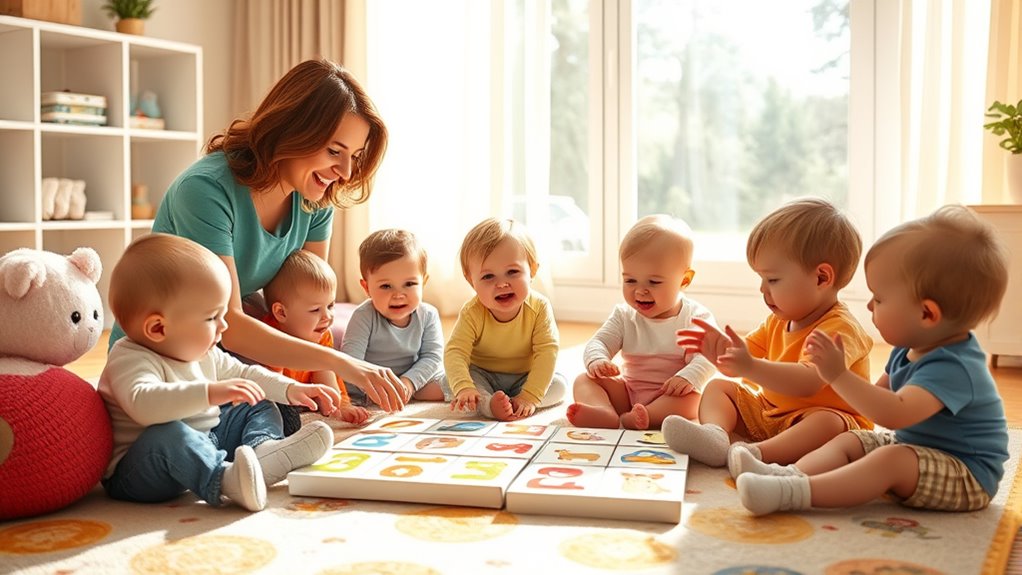
After playing memory card games, storytelling and repetition can considerably boost your child’s ability to recall information. Using storytelling techniques helps children connect ideas and remember details more effectively. Repetition strategies reinforce memory by encouraging repeated exposure to key concepts and images. To make this engaging, try these approaches:
- Use familiar stories to introduce new vocabulary or concepts
- Repeat key phrases during storytelling to enhance recall
- Incorporate visual aids and gestures to reinforce memory cues
- Encourage your child to retell stories in their own words
- Vary storytelling sessions to maintain interest and challenge memory
These strategies strengthen memory by making information more meaningful and easier to retrieve, supporting your child’s overall cognitive development.
Sequencing Activities to Develop Logical Thinking
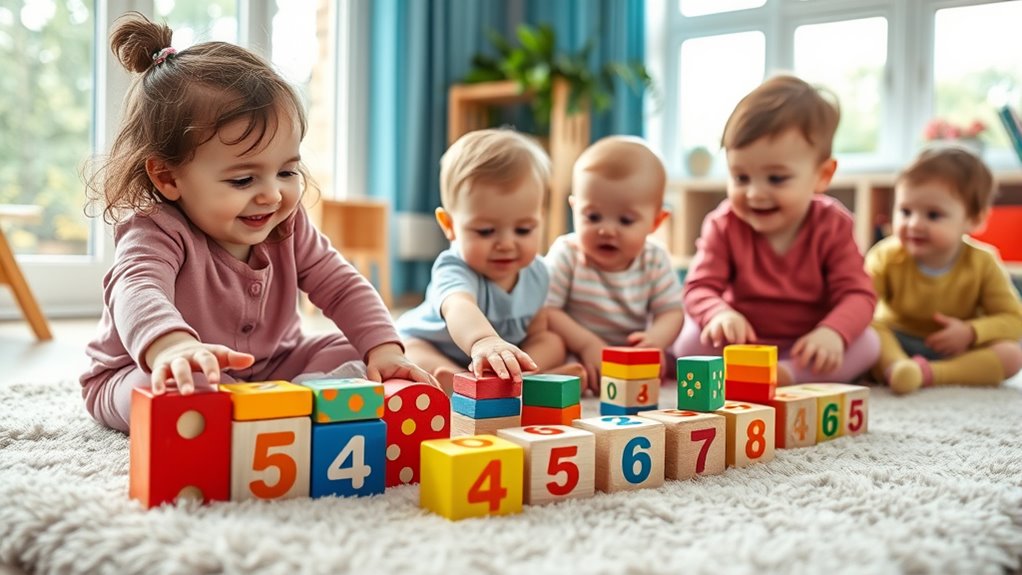
Engaging your child in sequencing activities is an effective way to develop their logical thinking skills. These activities help your child recognize patterns and understand cause and effect. For example, you can encourage them to arrange blocks in a specific order or complete simple puzzles. As they identify patterns, they learn to predict what comes next, strengthening their pattern recognition. Sequencing also shows cause and effect, such as pressing a button to make a toy light up. By practicing these skills, your child begins to understand how actions lead to outcomes, fostering critical thinking. Keep activities varied and fun, guiding them gently when needed. Over time, these exercises build a solid foundation for more complex reasoning and problem-solving skills.
Musical Games to Boost Auditory Memory
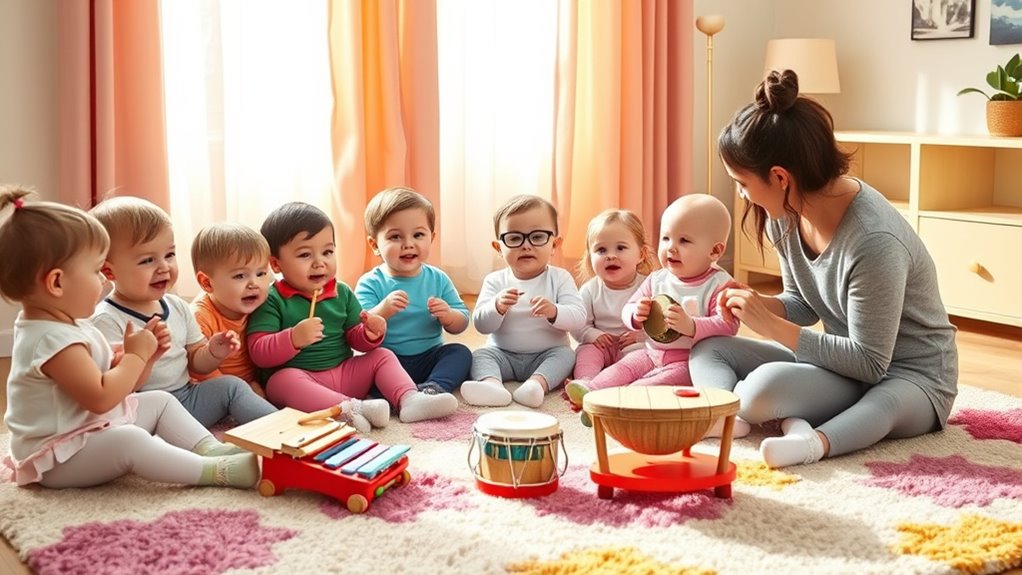
Playing musical games with your baby or toddler is a fun and effective way to enhance their auditory memory. These activities help them recognize sounds, rhythms, and patterns, strengthening their listening skills. You can sing simple songs, clap along to beats, or imitate sounds they make. Musical games encourage active listening and memory recall, laying a strong foundation for language development. To boost engagement, try these ideas:
- Sing familiar nursery rhymes with variations
- Play “copy the sound” games
- Use musical instruments for interactive play
- Create call-and-response songs
- Incorporate rhythmic clapping in daily routines
Sorting and Categorizing Activities for Cognitive Growth
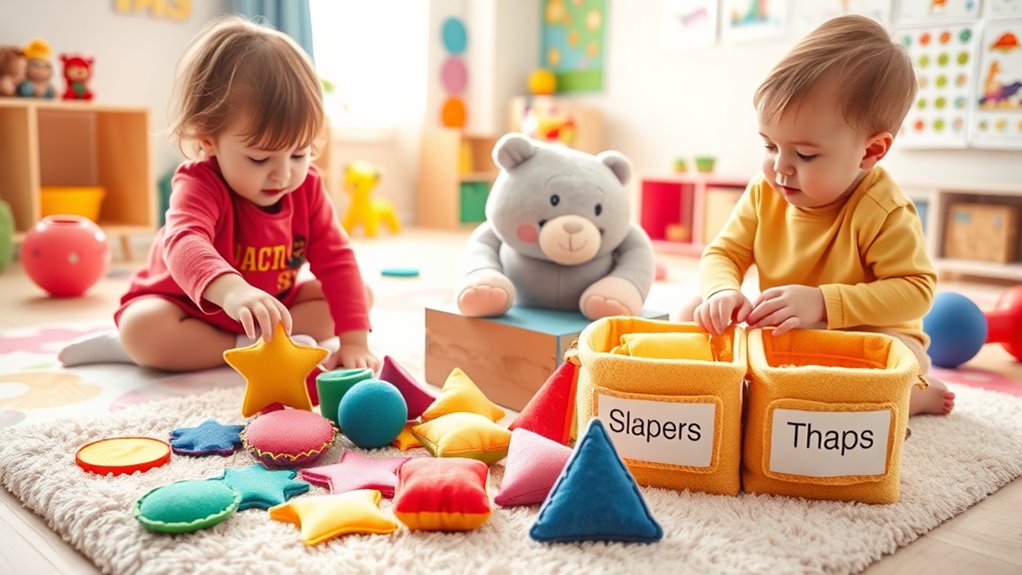
Sorting and categorizing activities are powerful tools to boost your baby’s or toddler’s cognitive development because they help them recognize differences and similarities among objects. Engaging in color sorting allows your little one to distinguish between vibrant hues, improving their visual discrimination skills. You can provide bowls or containers labeled with different colors, encouraging them to match objects accordingly. Shape categorization involves helping your child identify and group objects based on their forms, such as circles, squares, or triangles. Use toys or everyday items to facilitate this process. These activities enhance their ability to organize information, develop problem-solving skills, and build early conceptual understanding. Incorporating simple sorting and categorizing tasks into daily routines makes learning engaging and foundational for future cognitive growth.
Frequently Asked Questions
When Is the Ideal Age to Start Memory Games With Babies?
You should start memory games with your baby around 6 months old. At this age, their visual stimulation and sensory engagement skills are developing rapidly. Introducing simple games like peek-a-boo or hiding objects encourages them to focus and remember. As your baby grows, you can gradually increase complexity, helping boost their memory development through engaging activities that challenge their emerging cognitive abilities.
How Can Parents Track Their Child’s Memory Development Progress?
To track your child’s memory development progress, observe their responses to new experiences and note cognitive milestones over time. You can also use developmental assessments recommended by pediatricians to monitor their progress systematically. Keep a journal of your child’s behaviors, such as recalling familiar objects or people, and share these observations during check-ups. This helps you stay informed about their growth and address any concerns early on.
Are There Any Safety Concerns With Certain Memory Activities?
They say safety comes first, and that’s especially true with memory activities. You should always follow safety precautions and make sure proper activity supervision to prevent accidents. Avoid small objects that pose choking hazards, and choose age-appropriate games. Keep a watchful eye, and don’t rush or push your child into activities. When in doubt, consult a pediatrician. Your careful oversight helps make learning fun and safe for your little one.
How Do Memory Games Differ for Infants Versus Toddlers?
You’ll find that memory games differ for infants and toddlers mainly in how you focus on sensory engagement and attention span. For infants, keep activities simple, tactile, and visually stimulating to match their shorter attention span. With toddlers, introduce more complex games that challenge their growing memory and focus, while still maintaining sensory engagement. Adjusting the difficulty helps keep them interested and supports their developmental milestones effectively.
Can Daily Routines Serve as Effective Memory Development Tools?
Picture your daily routines as a gentle river, guiding your child’s memory development. Yes, routines with sensory stimulation and consistency create a familiar environment that helps your little one recognize patterns and remember details. These repeated activities, like brushing teeth or reading a book, strengthen neural connections. By maintaining routine consistency, you give your child a stable foundation to build their memory skills effortlessly every day.
Conclusion
By engaging your little one in these memory games, you’re setting the stage for incredible brain growth—faster than a rocket soaring to the stars! These activities not only boost recognition, recall, and logical thinking but also make learning fun and memorable. Keep playing, stay patient, and watch as their memory skills blossom like a garden in full bloom. With your support, your child’s mind will shine brighter than the brightest constellation.

